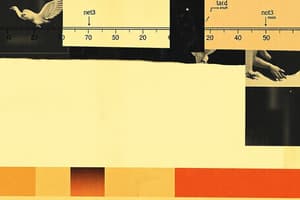Podcast
Questions and Answers
What is the primary purpose of using norm-referenced measures?
What is the primary purpose of using norm-referenced measures?
- To compare an individual's results to those of a peer group (correct)
- To evaluate a subject's growth over time
- To assess a subject's performance against a preset standard
- To analyze a subject’s skill without comparing it to others
In norm-referenced measurement, what is the key emphasis in how you use the data collected?
In norm-referenced measurement, what is the key emphasis in how you use the data collected?
- Focus on the absolute level of a subject's performance.
- Focus on determining a subject's longtitudinal growth pattern.
- Focus on comparing an individual's performance with that of a group. (correct)
- Focus on assessing a predefined list of skills.
When might a researcher choose to use a norm-referenced rather than a different type of measure?
When might a researcher choose to use a norm-referenced rather than a different type of measure?
- When assessing progress against individual prior achievements.
- When evaluating mastery of a fixed set of established criteria.
- When defining a cut-off point for competence.
- When aiming to rank an individual's performance within a cohort. (correct)
What is the defining characteristic of the comparison group in norm-referenced assessments?
What is the defining characteristic of the comparison group in norm-referenced assessments?
In norm-referenced interpretation, what does a subject's score represent?
In norm-referenced interpretation, what does a subject's score represent?
What best describes the role of the respondent mentioned?
What best describes the role of the respondent mentioned?
In which setting is the PNP student practicing, according to the information provided?
In which setting is the PNP student practicing, according to the information provided?
Which population is the respondent most likely to interact with in their practice?
Which population is the respondent most likely to interact with in their practice?
Which of the following statements is least true about the identified respondent?
Which of the following statements is least true about the identified respondent?
Which of the following roles does the setting imply that the PNP student might fulfill?
Which of the following roles does the setting imply that the PNP student might fulfill?
Flashcards
Respondent
Respondent
The person or entity providing information in a survey or research study.
Description of Respondent
Description of Respondent
A specific characteristic or attribute of the respondent that is relevant to the study.
Setting of Respondent
Setting of Respondent
The setting where the respondent is located during the data collection process.
PNP Student in Pediatric Ambulatory Care Center
PNP Student in Pediatric Ambulatory Care Center
Signup and view all the flashcards
Pediatric Ambulatory Care Center
Pediatric Ambulatory Care Center
Signup and view all the flashcards
Norm-referenced measures
Norm-referenced measures
Signup and view all the flashcards
Comparison group
Comparison group
Signup and view all the flashcards
Norm-referencing
Norm-referencing
Signup and view all the flashcards
When to use norm-referenced measures
When to use norm-referenced measures
Signup and view all the flashcards
Benefits of norm-referenced measures
Benefits of norm-referenced measures
Signup and view all the flashcards
Study Notes
Topic 1
- Strategies for Designing Measurement Tools and Procedures
- Norm-referenced and criterion-referenced approaches are the two major frameworks in measurement.
- Norm-referenced measures evaluate a subject's performance relative to a comparison group.
- Criterion-referenced measures evaluate a subject's performance relative to a predetermined set of target behaviors.
Topic 2
- Measurement Reliability
- Reliability is the extent to which measurements are repeatable by the same individual or different individuals using the same measure.
- It's concerned with consistency in performance.
- Reliability issues include imprecision in the measure or procedure, temporal factors, individual differences during measurement, and imprecision in administration or scoring.
Topic 3
- Validity
- Validity assesses a measure's capability to accurately represent a concept it targets.
- Types of validity include content validity, criterion-related validity, and construct validity.
- Content validity examines how well a set of items reflects a content domain.
- Criterion-related validity evaluates an item's association with a criterion (gold standard).
- Construct validity assesses the variable's theoretical relationship to other variables.
Topic 4
- Guidelines in Scale Development
- Clearly define the construct to be measured.
- Generate an item pool representative of the construct.
- Evaluate item performance (e.g., relevance, clarity, variances).
- Optimize item selection and scale length.
- Establish validity and reliability standards.
Topic 5
- Standardized Approaches to Measurement
- Standardized tests involve consistent procedures for developing, administering, and scoring the measures.
- Norms are used for comparing scores to a larger population
- Standardized measures excel at measuring stable attributes.
Topic 6
- Questionnaires
- Questionnaires are self-administered forms collecting data.
- Includes both closed- and open-ended questions and various scales.
- They are versatile but can be susceptible to issues like social desirability or acquiescence biases.
Studying That Suits You
Use AI to generate personalized quizzes and flashcards to suit your learning preferences.




